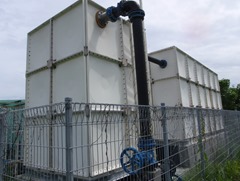 Provision of safe water supply and sanitation, particularly in the wake of the 2004 tsunami, has become an urgent task for the Maldives Government.
Provision of safe water supply and sanitation, particularly in the wake of the 2004 tsunami, has become an urgent task for the Maldives Government.
The Ministry of Housing, Transport and Environment (MHTE) developed an action plan for the implementation of water supply and sewerage projects in tsunami-affected islands and focus islands for regional development. A large range of reconstruction projects are now underway to upgrade or create new sewerage systems on as many islands as possible using the most appropriate technologies suited to the local conditions and that will result in environmental improvement. This included projects for the replacement of damaged septic tanks, the installation of new septic tanks, sewer pipe networks and treatment systems (MEEW, 2008). The project is funded by Agence Française de Développement (AFD) and the Maldives Government.
The most relevant guidelines used in this sewerage project were derived from two national guidelines (1) Design Criteria for Sewerage Systems (MWSA, 2007a) and from the (2) National Waste Water Quality Guidelines (NWWQG) (MWSA, 2007b). That information, along with lessons learned from the scientific literature was used as the basis for this EIA.
In the four islands raw and attenuated sewage enters the island and nearshore marine environments either through infiltration from septic systems or in outfalls that empty within the house reef area. All of the islands are showing signs of sewage pollution in their groundwaters and nearshore lagoons, with the magnitude of impacts being roughly proportional to the population density and the degree to which the lagoon traps nutrients (lowest on Gan and highest on Velidhoo).
Image: Left are islands with large populations showing enrichment in the lagoons (by seagrasses). Right are unpopulated islands showing what the lagoon areas should look like.
The literature on sewage on coral reefs suggests:
1. The impacts of sewage pollution on small islands and their house reefs are significant and affect the environment and the people living on the islands. Impacts come from nutrient enrichment, increases in sedimentation and changes in topographic complexity leading to pollution of groundwaters, nearshore areas and the house reef. Obvious signs are reduced groundwater quality, algal overgrowth and blooms, increased turbidity of waters, reduction in coral cover and diversity and other effects. The impacts can also result in human health risks from microbial contamination and effects on the growth of reef and sand-forming organisms critical to island growth and maintenance;
2. Ocean outfalls should be developed in preference to other alternatives. The ocean is a far larger and more suitable receiving environment for sewage in all forms than islands or house reefs and rarely show significant impacts if well-flushed areas are used (as is generally available in Maldives);
3. Any treatment options that result in separated fractions of sewage should ensure that the treated fraction is not disposed of within the reef system. That is, septage should also be disposed of to the ocean;
4. Sewage treatment can itself lead to additional environmental problems such as the requirement for land where it is very limited and risks associated with spills or discharge to groundwater and lagoon areas;
5. Conclusion: Sewage should be collected and transmitted off the islands and house reef areas as quickly and efficiently as possible to minimise the amount that can enter those environments. Any sewerage collection and treatment system that slows the process of conveying sewage off the island-house reef area carries with it significant risks for humans and the environment.
References
- Kaly, U.L., 2010. Environmental Impact Assessment (EIA):
Sewerage Systems for L. Gan, G.Dh. Thinadhoo, N. Velidhoo and N. Holhudhoo Islands, Maldives. Report to MHTE, 106pp. - MEEW, 2007a. Environment Impact Assessment Regulations. 1-64, Ministry of Environment, Energy and Water.
- MEEW, 2007b. Maldives Environmental Assessment Regulations. Ministry of Environment,Energy & Water, Male, Republic of Maldives.
- MEEW, 2008. Request for Proposals (RFP) to carry out Consulting Services for the Detailed Design and Works Supervision for development of sewage systems for the islands of Laamu Gan, Gdh.Thinadhoo, N. Velidhoo, N. Holhudhoo.
- MWSA, 2007a. Design Criteria for Sewerage Systems. 1-14, Maldives Water and Sanitation Authority.
- MWSA, 2007b. National Waste Water Quality Guidelines: Maldives (Revision 1). 1-24, Maldives Water and Sanitation Authority (MWSA).

